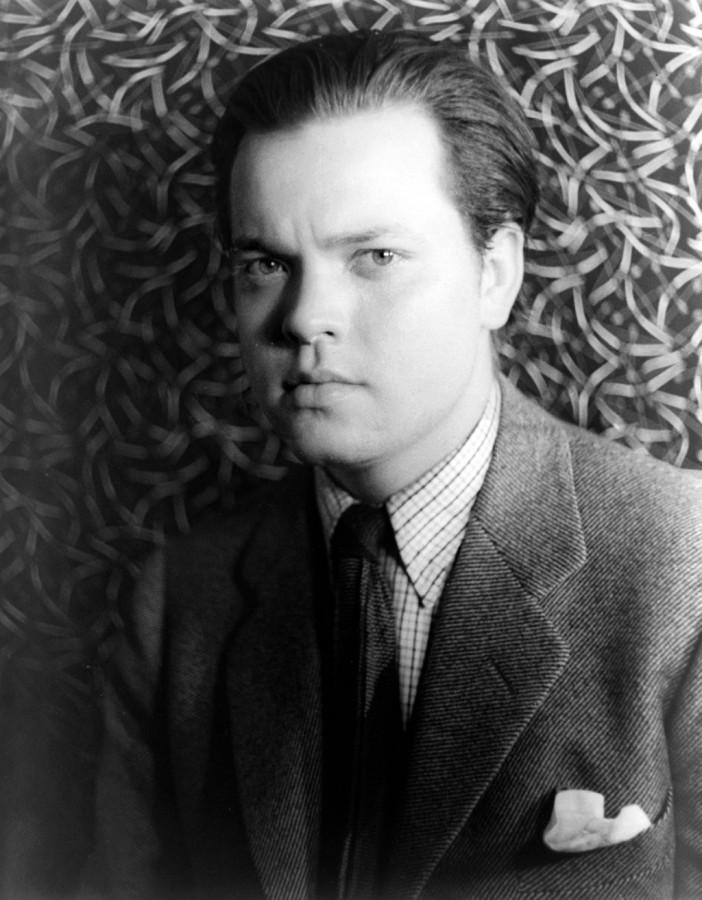Remembering Orson Welles At 100
July 15, 2015
By Bob Hoover
The second child of inventor Richard and opera singer Beatrice Welles was born 100 years ago May 6 in Kenosha, Wis. They named him George Orson Welles, but it didn’t take long before he shed George and Kenosha to become one of the best-known showmen in America.
At 21, he shook up the dull, predictable Broadway theater world with an all-black production of “Macbeth,” then followed it with a chilling modern-dress “Julius Caesar” in 1937 as fascism gripped Germany and Italy. His sonorous voice was heard on so many live radio dramas that he hired an ambulance, with siren wailing, to get him from job to job in Manhattan traffic.
Kicked out of one theater when the government shut down his Federal Theatre Project production of the left-wing musical “The Cradle Will Rock,” he marched the cast down Broadway to an empty theater and staged Marc Blitzstein’s attack on American capitalism.
Welles formed the Mercury Theatre on the Air in 1938 on CBS radio to present hour-long versions of classics with a talented cast and crew, but the Sunday night show had no sponsors. Inspired by the live broadcasts of the European crisis that year, he and writer Howard Koch (he would go on to co-write “Casablanca”) rewrote H.G. Wells’ “The War of the Worlds” as news bulletins interrupting musical programs.
The Halloween broadcast was a sensation, earning Welles sponsors, the cover of Time magazine (at 23) and a film contract granting him unheard-of creative freedom in Hollywood. Accused of causing panic among listeners, Welles said, “I didn’t go to jail; I went to Hollywood instead.”
While the film establishment shunned and ridiculed this upstart, Welles and his Mercury crew, including composer Bernard Herrmann, using “the biggest train set a boy ever had” (the RKO studios) turned out what is still considered one of the best films of all time, “Citizen Kane.”
In the latest 10-year Sight and Sound magazine poll in 2012, Alfred Hitchcock’s “Vertigo” knocked “Kane” to second place after 60 years on top.
Welles turned 25 just after the film premiered May 1, 1941. What followed this most meteoric rise was an equally meteoric fall from Hollywood grace. The brash “boy genius” became an overweight, jowly has-been in most eyes, and Welles went into self-exile in Europe doing hack acting work to raise money for a series of underfunded and little-watched films.
Whenever someone quotes the well-worn F. Scott Fitzgerald line, “There are no second acts in American lives,” Orson Welles’ name automatically comes up.
Commonly viewed as a classic example of failure, Welles, in fact, was not.
He was an artist on his own terms struggling outside the world of American commercial success for most of his life, which ended in 1985 when he was 70. By then, needing money, he became known as a winery TV pitchman vowing “to sell no wine before its time.” He made the rounds of the talk shows, even appeared on “The Dean Martin Show” and tried with little success to make more movies.
Welles’ scholar Jonathan Rosenbaum observes that while “obituaries outside America devoted themselves almost exclusively to Welles’ many accomplishments . . . repeated refrains in his home country seemed to concentrate on his weight and the specter of failure . . . Welles’ artistic career seemed to consist of a spectacular debut followed by 40-odd years of inactivity.”
Orson Welles was not completely ignored in his lifetime. The Museum of Modern Art held the first retrospective of his career in 1961. Both the Academy Awards and the American Film Institute honored him in 1971 and 1975, respectively, and he has won numerous international awards.
After Sight and Sound magazine’s first poll in 1952, “Kane” waited 11 years to gain widespread recognition. It lost money — $18,000 — for RKO in 1941 because of a campaign of suppression instigated by press baron William Randolph Hearst and because it was such a departure from standard movies that audiences stayed away in droves. Hearst was convinced that the Kane character was based on his life, and he influenced several studio heads, particularly Louis B. Mayer of MGM, to deny RKO access to its local theaters.
Welles was nominated for the Academy Awards for best actor and best director for “Kane,” and he shared the Oscar for best screenplay with co-author Herman Mankiewicz, a controversial relationship steeped in jealousy and re-ignited by a now-discredited essay by former New Yorker magazine film critic Pauline Kael.
The movie was shelved and not seen for many years. The original negative, with its sharp black-and-white cinematography, was destroyed in a 1970 fire. Until a print was digitally reworked several years ago, the details of its complex frames were blurry and indistinct.
After shooting his second RKO feature, “The Magnificent Ambersons,” his most personal and sympathetic work, Welles entangled himself in a misguided foreign policy adventure in Brazil as the United States entered World War II. It was a disaster that not only cost the lives of several poor fishermen, but also cost Welles his job at RKO.
“The Magnificent Ambersons,” released in 1942, was based on a novel by Booth Tarkington, a friend of Welles’ father. It portrayed the end of the 19th century by industrialization of the 20th, symbolized by the “horseless carriage.”
RKO executives told film editor Robert Wise, now best known for directing “The Sound of Music” 50 years ago, to trim “Ambersons” by nearly 30 minutes and shoot a positive ending. A print of Welles’ original version was probably thrown away when Desi Arnaz and Lucille Ball bought the RKO studios to film their TV sitcom “I Love Lucy” in the 1950s and cleaned out the film vault. It has never been found.
Welles, who lived in the mansions of former film stars and married sex-symbol actress Rita Hayworth, was reduced to playing roles in such films as “Jane Eyre,” “The Third Man” and “Moby Dick.” He was a liberal political spokesman during the war years campaigning with Frank Sinatra for President Franklin Roosevelt with a tour that included a speech in Forbes Field in 1944.
He directed a few more movies in Hollywood — “The Stranger” (1946), “The Lady From Shanghai” (1947), “Macbeth” (1948) and “Touch of Evil” (1958). Welles spent time in Europe, where he could make his films his way, although always on a shoestring budget. He managed to complete “Othello,” “Mr. Arkadin,” “The Trial,” “Chimes at Midnight” and “The Immortal Story.”
Several other projects, most notably his version of “Don Quixote,” were unfinished.
Welles’ fondness for Shakespeare — “Chimes at Midnight” might be his best film (he plays Falstaff) and certainly one of the finest versions of the Bard — reflects his appreciation for entertaining his audiences. He was not an intellectual snob, but a showman who valued the theatrical experience.
“Citizen Kane” is fun. Its exuberance and energy seem as fresh and unusual as they did in 1941. Its 24-year-old director and star loved to tell stories, even if they were as obvious and predictable as the life of Charles Foster Kane.
Forgive Orson his excesses from steaks and milkshakes to impossible dreams and wish him a happy birthday wherever he is.
©2015 Pittsburgh Post-Gazette
Visit the Pittsburgh Post-Gazette at www.post-gazette.com
Distributed by Tribune Content Agency, LLC.
















